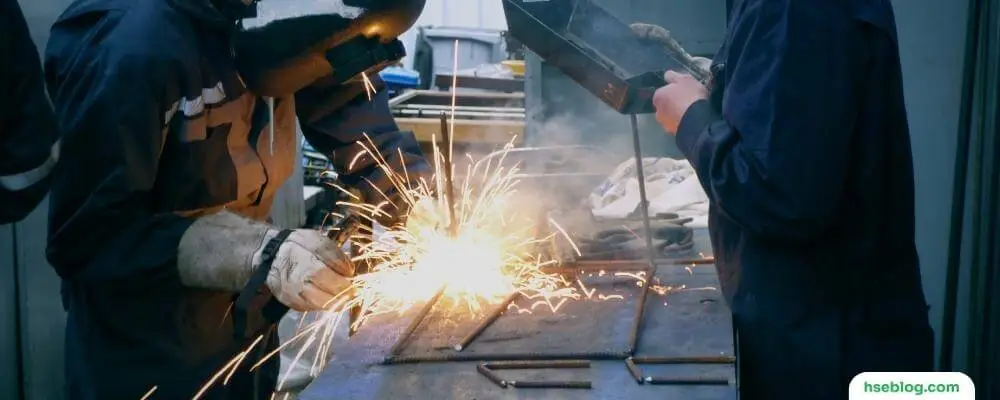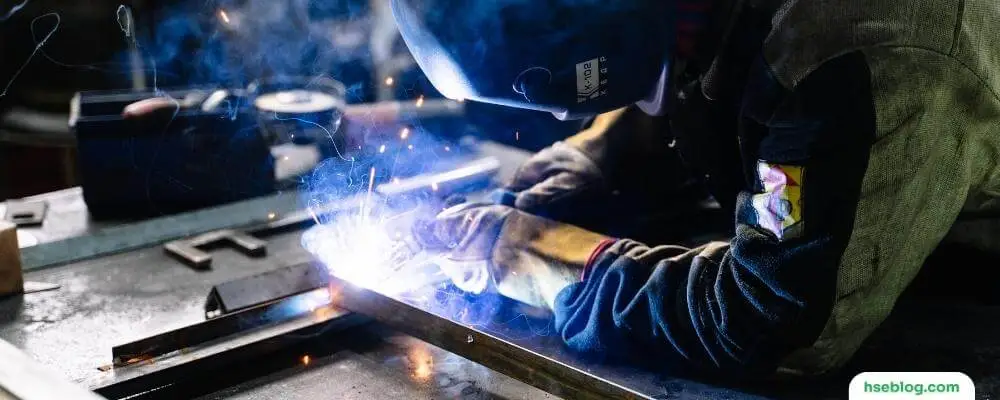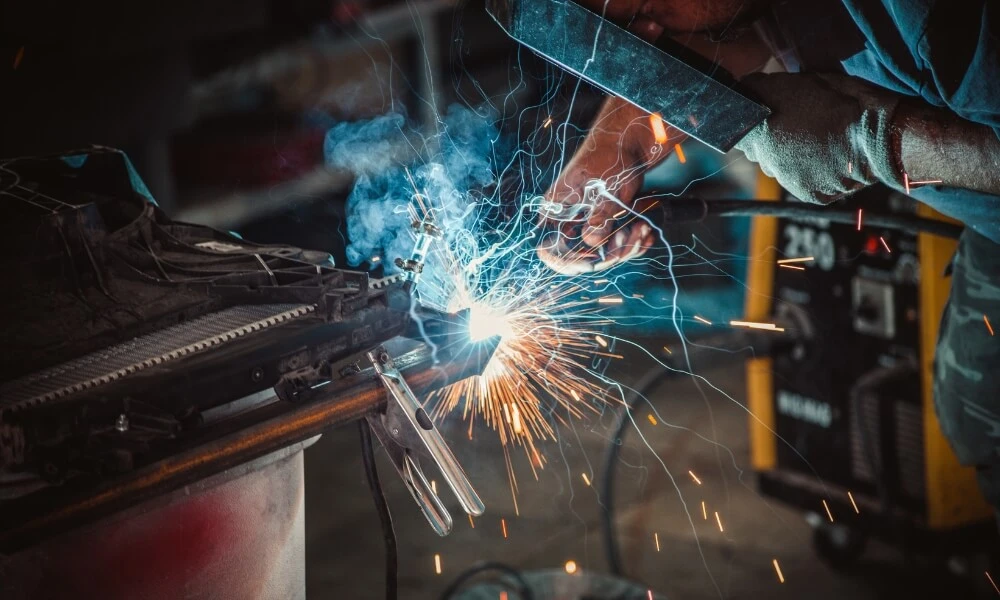Welding is a critical industrial process that joins metals, forming the backbone of countless infrastructure projects and manufacturing operations. However, it’s essential to recognize that welding also carries inherent risks. From electric shock to toxic fumes, the welding environment presents various hazards that can jeopardize the safety and well-being of workers if proper precautions are not taken.
In this blog, we will explore ten common hazards encountered in welding operations and delve into the control measures that can be implemented to mitigate these risks effectively. By understanding these hazards and following the recommended safety measures, welders and their employers can create a safer working environment, reduce the incidence of accidents, and ensure optimal productivity.
This blog will address hazards such as electric shock, fumes and gases, fire and explosions, radiation exposure, physical injuries, noise, repetitive stress injuries, compressed gases, inadequate training, and poor housekeeping. For each hazard, we will explain the risks involved and the control measures that can be implemented to minimize or eliminate those risks.
What is Welding?
Welding is a fabrication process involving combining two or more pieces of metal using heat and pressure. It is fundamental in various industries, including construction, manufacturing, automotive, and aerospace. The primary purpose of welding is to create a strong and permanent bond between metals, allowing them to function as a single, unified structure.
During welding, a heat source, typically an electric arc or a flame, is used to melt the base metals, and a filler material is added to create the weld joint. The melted metal solidifies, forming a strong and durable connection. Welding techniques vary depending on the specific application, such as shielded metal arc welding (SMAW), gas metal arc welding (GMAW), tungsten inert gas welding (TIG), and many others. Welding is critical in constructing buildings, bridges, pipelines, vehicles, and various fabricated metal products.

10 Common Hazards and Control Measures
Welding can be a dangerous occupation if proper precautions aren’t taken. Here are 10 common hazards you might encounter during welding and the control measures you can take to ensure safety:
1. Electric Shock
Electric shock is one of the most severe risks welders face and can be fatal. An electric shock occurs when a welder directly contacts two metal objects with a voltage between them. There are two types of electric shock:
- Primary Voltage Shock: This can occur when a welder touches a part of the energized welding or electrode circuit at a voltage potential. These circuits have enough voltage (hundreds of volts) to cause a fatal electric shock.
- Secondary Voltage Shock: This is the most common type of electric shock. It happens when a welder touches a part of the welding or electrode circuit with one hand while the other hand touches a portion of the metal being welded, which is grounded. The voltage involved here is lower (tens of volts), but under certain conditions can still cause death.
Control Measures for Electric Shock:
- Proper Insulation: Always wear dry, hole-free gloves for insulation. Inspecting your gloves frequently for any signs of wear and tear, as even small pinholes can expose the skin to electric current.
- Equipment Grounding: The welding machine and workpiece should be properly grounded. Grounding provides a safe, controlled path for electric current to reduce the risk of electric shock.
- Safety Equipment: Use safety equipment such as insulated electrode holders. Never use holders with damaged insulation.
- Safe Environment: Keep your work environment dry as much as possible. Electric current can travel through a wet environment or wet clothing more easily, increasing the risk of shock.
- Proper Equipment Maintenance: Regularly inspect and maintain your welding equipment. Look for any signs of wear, damage, or faulty wiring that could lead to an electrical fault.
- Follow Manufacturer’s Instructions: Always follow the welding equipment manufacturer’s instructions. Incorrect setup or equipment usage can lead to an increased risk of electric shock.
- Proper Training: Adequate training should ensure that welders understand the potential hazards and how to use the equipment safely to minimize the risk of electric shock.
Remember, safety must always be the priority when welding. Even though electric shock from welding is not common, when it does occur, it can be fatal. By following these control measures, you can significantly reduce the risk.
2. Fumes and Gases
Welding produces fumes and gases that can be harmful and, in some cases, deadly if inhaled. The specific fumes and gases produced depend on the type of welding being performed and the materials being used. These can include gases like argon, helium, carbon dioxide, nitrogen, and others. The fumes can contain potentially harmful metals such as aluminum, beryllium, lead, and manganese, among others.
Prolonged exposure to these fumes and gases can lead to several health issues. Short-term effects include dizziness, nausea, and irritation of the eyes, nose, and throat. Long-term exposure can lead to serious health problems like lung damage, cancer, and neurological effects.
Control Measures for Fumes and Gases:
- Ventilation: This is one of the simplest and most effective methods of controlling welding fumes. The workspace should be well-ventilated to dilute the concentration of fumes and gases. Natural ventilation can be sufficient for some types of welding. Still, mechanical ventilation systems may be necessary for more intense welding operations or welding in a confined space.
- Fume Extraction Systems: These systems are designed to remove the fumes at the source before they can be inhaled by the welder. This can include on-gun extraction or larger extraction systems for fixed workstations. Regular maintenance of these systems is crucial to ensure they are working properly.
- Respiratory Protection: Even with good ventilation and fume extraction, some respiratory protection may still be necessary, particularly for certain welding or confined spaces. This can range from simple dust masks to more complex respirators, depending on the level of protection needed.
- Work Practice Controls: This involves adjusting your work to reduce exposure to welding fumes. For example, positioning your head to the side of the fumes rather than directly above the work or using a technique that produces fewer fumes.
- Material Selection: Where possible, select materials that generate less toxic fumes. For example, choose welding wires that produce fewer fumes.
- Regular Health Checks: Regular health check-ups can help detect potential health issues early. These checks can include lung function and blood tests for exposure to certain metals.
Taking these precautions can significantly reduce the risks associated with exposure to harmful welding fumes and gases. Remember, the key to safe welding practices is awareness of the hazards and taking the necessary steps to minimize exposure.

3. Fire and Explosions
The welding process generates a lot of heat, sparks, and hot spatter, which can easily ignite combustible and flammable materials. In fact, welding is one of the leading causes of industrial fires and explosions. The danger can be exacerbated if welding is performed near storage areas for flammable substances or in environments where flammable vapors or gases may be present.
Welding can also cause “hidden fires.” These fires start in hidden areas, such as inside a wall or underneath the flooring, due to sparks or hot metal getting into small cracks and igniting materials hours after welding has finished.
Control Measures for Fire and Explosions:
- Remove Flammable Materials: The most effective way to prevent fires is to remove all flammable and combustible materials from where welding is performed. This includes obvious items like paper and fabric and less obvious ones like dust, grease, and flammable liquids or gases.
- Fire Extinguishers: Always keep an appropriate fire extinguisher nearby when welding. All workers should be trained in how to use the extinguisher correctly.
- Protective Covers: If flammable materials cannot be removed from the area, use fire-resistant blankets, curtains, or screens to protect them from sparks and spatter.
- Fire Watches: A fire watch should be posted for any welding operations near flammable materials that can’t be moved. This person’s job is to watch for any signs of fire during and after welding.
- Pre-Welding Inspection: Before starting welding work, inspect the area to identify potential fire hazards. Also, consider the possibility of hidden flammable materials in walls, floors, or ceilings.
- Check for Hidden Fires: After welding, wait for a period of time and check the area for any signs of hidden fires. It can sometimes take several hours for a fire to become visible.
- Proper Storage of Gases: Flammable gases used in the welding process, such as acetylene or propane, should be stored safely in accordance with regulatory requirements to prevent explosions.
- Hot Work Permits: A hot work permit may be required if welding is done in a potentially hazardous area. This permit confirms that all potential risks have been assessed and that appropriate safety measures are in place.
Remember, safety should be your first priority. Fires and explosions can cause massive damage and potentially result in injury or death, so it’s crucial to take all necessary precautions when welding.
4. Radiation Exposure
Welding arcs produce bright visible light and ultraviolet (UV) and infrared (IR) radiation. Exposure to these forms of radiation can have several harmful effects:
- UV Radiation: UV radiation from the welding arc can cause a “welder’s flash” or “arc eye,” a painful condition where the cornea is inflamed. Long-term exposure to UV radiation can lead to cataracts.
- IR Radiation: Infrared radiation is primarily a source of heat. High levels of IR radiation can cause burns to the skin and eyes.
- Visible Light: The intense visible light produced by a welding arc can cause damage to the retina, which may be either temporary or permanent.
Control Measures for Radiation Exposure:
- Welding Helmets: A welding helmet fitted with the appropriate filtered lens is crucial to protect your eyes and face from radiation. The lens shade should be chosen based on the type and intensity of the welding being done.
- Safety Glasses: Wear safety glasses with side shields under your helmet for additional eye protection, particularly from reflected or scattered light.
- Protective Clothing: Long-sleeved shirts, trousers without cuffs, high shoes, and a cap under your helmet can protect your skin from UV radiation. Fire-resistant treated cotton or wool is preferable. Synthetic materials should be avoided as they can melt and cause burns.
- Welding Curtains or Screens: These can be used to protect other workers in the area from the welding arc’s radiation.
- Proper Technique: Avoid looking at the welding arc without eye protection. Even brief exposure can cause damage to your eyes.
- Regular Breaks: Taking regular breaks can reduce your total radiation exposure.
By following these control measures, you can significantly reduce your risk of harm from the radiation produced by welding. Always prioritize safety when welding, and ensure all necessary protective measures are in place before you begin.

5. Physical Injury
Welding often involves the use of heavy equipment and materials, and the nature of the work can put welders at risk for various types of physical injuries. These can include cuts, burns, and injuries from falls or being struck by falling objects. Using high heat and powerful tools also presents risks if handled incorrectly.
Here are some hazards that can lead to physical injuries and the control measures to prevent them:
Hazards:
- Falls: Trips, slips, and falls can occur if cables, equipment, or materials are left around the workspace.
- Cuts and Burns: Handling sharp materials or hot equipment without proper protection can lead to cuts or burns.
- Being Struck by Objects: Falling objects or being struck by moving equipment can cause serious injury.
- Improper Use of Tools: Using tools incorrectly or the wrong tool for the job can lead to injury.
Control Measures:
- Keep Workspace Tidy: Keep your work area as tidy as possible. Regularly remove any unnecessary equipment or materials to maintain a clear workspace. This reduces the chance of tripping over objects left on the floor.
- Use the Right Tool for the Job: Make sure to use the appropriate tool for the job at hand. Using the wrong tool can be dangerous and lead to accidents. Also, never use a tool in a way it’s not intended to be used.
- Proper Maintenance of Tools: Regularly inspect and maintain your tools. This can help ensure that they function correctly, and it can prevent accidents caused by malfunctioning equipment.
- Use Protective Equipment: Always wear appropriate personal protective equipment (PPE). This could include safety gloves, steel-toe boots, and hard hats. The exact equipment will depend on the specifics of the job and the hazards present.
- Proper Training: Proper training on equipment and tools is crucial. Training should include not only how to use the equipment but also how to maintain it and how to recognize potential hazards.
- Secure Materials and Equipment: To prevent them from falling and causing injury, secure materials and equipment properly. Also, be cautious when lifting heavy objects to avoid injury.
- Follow Safety Protocols: Every workshop should have safety protocols in place, and it’s crucial to follow these at all times.
These control measures can significantly reduce the risk of physical injury when welding. Remember that safety should always be your top priority, and don’t rush a job at the expense of safety.
6. Noise
Noise is a common hazard in many industrial environments, including welding. The welding process itself, along with associated activities such as grinding or cutting, can produce high levels of noise. Prolonged exposure to these noise levels can lead to noise-induced hearing loss (NIHL), tinnitus (ringing in the ears), and other auditory issues. In extreme cases, it could lead to permanent hearing loss.
Control Measures for Noise Exposure:
- Use Ear Protection: Personal Protective Equipment (PPE) like earmuffs or earplugs should be worn, especially during high-volume welding operations. These devices reduce the level of noise that reaches the ears. Various types of ear protection are available, including disposable earplugs, reusable earplugs, and earmuffs. The choice depends on the noise level, comfort, and personal preference.
- Quiet Equipment and Processes: Choose equipment and processes that produce less noise. Some modern welding equipment is designed to operate more quietly.
- Regular Breaks: Regular breaks from the noise can help reduce overall exposure.
- Noise Barriers: In some situations, it may be possible to use noise barriers or enclosures around noisy equipment to reduce the level of noise that reaches other areas.
- Routine Hearing Checks: Regular hearing checks can help to identify any hearing loss early, allowing steps to be taken to prevent further damage.
- Training and Awareness: Workers should be trained on the hazards associated with noise exposure, the importance of wearing ear protection, and how to properly use and care for their hearing protection.
- Noise Control Measures: In some instances, engineering controls such as noise dampening or noise cancellation technologies might be utilized in the workplace to reduce overall noise levels.
Remember, hearing damage is often gradual, and the effects may not be noticed until significant damage has been done. It’s essential to take precautions to protect your hearing when working in noisy environments like welding workshops.

7. User Repetitive Stress Injury
Repetitive Stress Injuries (RSIs), also known as musculoskeletal disorders (MSDs), are common among welders due to the repetitive nature of the work and the physical demands placed on the body. These injuries can affect the muscles, tendons, ligaments, and other soft tissues, causing pain, discomfort, and reduced mobility.
Common Repetitive Stress Injuries in Welding:
- Tendonitis: Inflammation of tendons, typically in the hands, wrists, and elbows.
- Carpal Tunnel Syndrome: Compression of the median nerve in the wrist, leading to numbness, tingling, and weakness in the hand and fingers.
- Epicondylitis: Inflammation of the tendons in the elbow, commonly known as tennis elbow or golfer’s elbow.
- Back Strain: Muscle strain or sprain in the back due to heavy lifting or poor posture.
- Neck and Shoulder Pain: Resulting from long awkward positions and repetitive movements.
Control Measures for Repetitive Stress Injury:
- Take Regular Breaks: Frequent short breaks can help alleviate the strain on your muscles and joints. Use these breaks to stretch and relax the affected areas.
- Alternate Tasks: If possible, rotate between different tasks to avoid repetitive movements and give different muscle groups a chance to rest.
- Ergonomic Considerations: Use ergonomically designed tools and equipment that reduce strain on the body. This can include adjustable workbenches, ergonomic welding torch handles, and supportive seating.
- Proper Body Mechanics: Maintain proper posture and body mechanics during welding tasks. Lift heavy objects with your legs, not your back, and avoid awkward or extended reaching.
- Strengthening and Stretching Exercises: Engage in exercises that target the muscles used in welding to improve strength and flexibility. Consult a physical therapist or occupational therapist for guidance on suitable exercises.
- Use Assistive Devices: Utilize mechanical aids or assistive devices to reduce the physical strain associated with lifting or holding heavy objects.
- Workstation Setup: Set up your workstation to promote good posture. Adjust the height of your welding table, chair, and equipment to ensure a comfortable working position.
- Training and Education: Provide workers with proper training on ergonomic techniques, body mechanics, and injury prevention strategies. Promote awareness of the risks of repetitive stress injuries.
Early recognition and intervention are crucial for preventing and managing repetitive stress injuries. If you experience pain or discomfort, it’s important to consult a healthcare professional for evaluation and appropriate treatment.
8. Compressed Gases
Compressed gas cylinders are an essential component of many welding processes. However, they can pose significant risks if not handled and stored properly. One of the main hazards associated with compressed gas cylinders is their potential to become projectiles if damaged or mishandled.
Control Measures for Compressed Gas Cylinders:
- Secure Storage: Store gas cylinders in a secure and upright position. Use cylinder racks, stands, or cages to prevent them from falling or being knocked over. Secure them to a fixed structure if necessary.
- Ventilation: Store gas cylinders in well-ventilated areas to prevent the buildup of flammable or hazardous gases in case of a leak.
- Separation from Heat Sources: Keep gas cylinders away from heat sources, flames, and flammable materials. Avoid storing them near furnaces, welding arcs, or other heat-generated equipment.
- Proper Handling: Lift and move cylinders using appropriate handling equipment such as cylinder carts or trolleys. Never roll or drag cylinders.
- Valve Protection: Always keep the valve protection caps in place when the cylinder is not in use to prevent damage to the valve and accidental gas release.
- Use of Regulators and Check Valves: Always use pressure regulators and check valves when connecting gas cylinders to welding equipment. These devices help control the flow and pressure of gases, preventing sudden releases and ensuring safe operation.
- Proper Identification: Label and mark cylinders to identify their contents and potential hazards. This helps ensure that the correct gas is used for the intended application.
- Inspection and Maintenance: Regularly inspect gas cylinders for signs of damage or deterioration, such as corrosion, dents, or leaks. Follow manufacturer guidelines for periodic inspections, testing, and maintenance.
- Training and Education: Train workers on safely handling, storing, and using compressed gas cylinders. This should include proper procedures for connecting and disconnecting cylinders and emergency response protocols in case of a leak or accident.
It’s important to adhere to these control measures to minimize the risks associated with compressed gas cylinders. Mishandling or improper storage of these cylinders can result in severe injuries or property damage. Always follow relevant safety guidelines and regulations specific to your location and consult with safety professionals or gas suppliers for additional guidance.

9. Inadequate Training
Inadequate training is a significant risk factor in welding, as it can lead to incorrect operation of welding equipment, increased likelihood of accidents, and mistakes that compromise safety. Proper training is crucial for ensuring that welders have the knowledge and skills necessary to perform their work safely and effectively.
Control Measures for Inadequate Training:
- Comprehensive Training Programs: Implement comprehensive training programs that cover all aspects of welding safety. Training should include theoretical knowledge, practical skills development, and hazard identification and mitigation techniques.
- Equipment-Specific Training: Provide training specific to the equipment and welding processes being used in your facility. This ensures welders understand the proper operation, setup, and maintenance of the equipment they work with.
- Qualified Instructors: Ensure that training is conducted by qualified instructors with expertise and experience in welding safety. Instructors should thoroughly understand industry standards and best practices.
- Hazard Awareness and Mitigation: Train welders to identify potential hazards associated with the welding process and teach them how to implement appropriate control measures. This includes understanding the risks associated with electric shock, fire hazards, fumes and gases, radiation, and other common hazards.
- Safety Protocols: Train welders on following safety protocols and standard operating procedures. This includes using appropriate personal protective equipment, adhering to safe work practices, and reporting safety concerns.
- Continuous Education: Encourage ongoing education and professional development for welders to stay updated with the latest safety standards, techniques, and equipment advancements.
- Supervision and Mentorship: Provide supervision and mentorship to newly trained welders to ensure they gain experience under the guidance of experienced welders who can help reinforce safe practices.
- Regular Safety Meetings and Refresher Training: Conduct regular safety meetings and refresher training sessions to reinforce knowledge and address any new safety concerns or updates.
By providing proper training, employers can equip welders with the necessary skills and knowledge to perform their work safely. This reduces the likelihood of accidents, injuries, and mistakes due to inadequate training. Remember, ongoing commitment to training and safety culture is vital for maintaining a safe working environment in welding operations.
10. Poor Housekeeping
Poor housekeeping in welding workspaces can create hazardous conditions that increase the risk of accidents and injuries. Cluttered work areas can lead to tripping hazards, falling objects, and difficulty in maneuvering safely. It’s important to maintain a clean and organized workspace to promote a safe working environment.
Control Measures for Poor Housekeeping:
- Regular Cleaning and Maintenance: Establish a regular cleaning schedule for the workspace, including sweeping the floor, removing debris, and clearing spills. This helps prevent slips, trips, and falls.
- Proper Storage: Provide designated storage areas for tools, equipment, and materials. Keep them organized and ensure they are returned to their proper places after use.
- Clear Walkways and Aisles: Keep walkways and aisles free from obstacles and clutter. Remove any unnecessary items or equipment that obstruct the paths.
- Proper Waste Disposal: Implement a proper waste management system. Dispose of waste materials, such as metal shavings or discarded consumables, in designated containers promptly.
- Tripping Hazard Identification and Removal: Regularly inspect the workspace for potential tripping hazards, such as loose cables, hoses, or uneven flooring. Promptly repair or address any identified hazards to minimize the risk of accidents.
- Proper Material Handling: Use appropriate lifting techniques and equipment to prevent strains or injuries when moving heavy objects. Avoid stacking materials unsafely, especially where they can fall and cause harm.
- Safety Signage: Use clear and visible signage to indicate potential hazards and remind workers to maintain a clean and organized workspace.
- Employee Awareness and Training: Educate employees about the importance of good housekeeping practices and their responsibility to maintain a safe work environment. Promote a culture of cleanliness and organization.
- Regular Inspections: Conduct routine inspections to assess housekeeping practices and identify areas that require improvement. Promptly address any issues or non-compliance with established housekeeping standards.
Maintaining good housekeeping practices in welding workspaces prevents accidents and injuries and promotes efficiency and productivity. It is a shared responsibility among all workers to keep the workspace clean and organized. By prioritizing regular cleaning, organization, and hazard identification, a safer work environment can be achieved.

Additional Welding Safety Rules To Follow
In addition to the specific hazards and control measures discussed earlier, here are some additional general safety rules that welders should follow:
- Wear Appropriate Personal Protective Equipment (PPE): Always wear the required PPE, including welding helmets, safety glasses, flame-resistant clothing, gloves, and steel-toed boots. Ensure that the PPE is in good condition and fits properly.
- Inspect Welding Equipment: Before starting any welding job, inspect the equipment for any damage, leaks, or malfunctions. Report any issues to the appropriate personnel, and do not use faulty equipment.
- Prepare the Work Area: Clear the work area of flammable materials, clutter, and unnecessary items. Ensure that fire extinguishers and other safety equipment are readily accessible.
- Secure Grounding: Ensure that the welding machine and workpiece are properly grounded to minimize the risk of electric shock.
- Follow Safe Work Practices: Adhere to established safe work practices and standard operating procedures. This includes proper materials handling, safe gas cylinder storage, and appropriate lifting techniques.
- Never Weld on Containers That Held Flammable Substances: Never weld on containers that previously contained flammable or hazardous materials, as residual substances can react and cause explosions or toxic fumes.
- Work in a Well-Ventilated Area: Ensure the area is adequately ventilated to minimize exposure to welding fumes and gases. If working in confined spaces, implement proper ventilation or use respiratory protection as necessary.
- Avoid Welding in Wet Conditions: Do not weld in wet or damp conditions, as moisture can increase the risk of electric shock and affect the quality of the weld.
- Proper Handling and Storage of Gas Cylinders: Handle and store gas cylinders carefully, ensuring they are secured and protected from heat, flames, or physical damage. Follow specific guidelines for each type of gas.
- Know Emergency Procedures: Familiarize yourself with emergency procedures, including evacuation plans, first aid measures, and how to respond to fire or injury incidents. Ensure that all necessary emergency contact information is readily available.
Remember, safety should always be a priority in welding operations. Following these additional safety rules and the control measures for specific hazards can help ensure a safe and productive welding environment. Regular training, awareness, and ongoing commitment to safety are essential for all individuals involved in welding activities.
Conclusion
welding safety is paramount to protect workers’ well-being and prevent accidents in welding operations. By understanding the ten common hazards discussed in this blog, such as electric shock, fumes and gases, fire and explosions, and taking appropriate control measures, including wearing proper personal protective equipment, maintaining good housekeeping, and receiving adequate training, welders, and employers can create a safer working environment.
By implementing these control measures and fostering a safety culture, we can ensure that welding remains a productive and secure process while safeguarding the health and safety of all involved.

